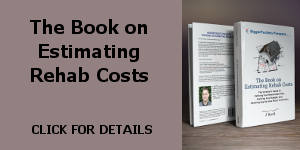Now that I’m in the process of getting my first house ready to put on the market, I’m starting to think about the types of things that will likely make the difference between selling quickly and not selling quickly (or at all), and the things that will make the difference in how much I can sell for. I’m a big believer that staging a property (strategically placing furniture in the house, as opposed to leaving it empty or having it look “too lived in”) will not only allow sellers to sell more quickly, but also at a higher price.
In fact, over the past week, my wife has purchased an entire house full of furniture, just to be used to stage our properties for sale. We’ve even started staging The Bulge House, which we hope to put on the market on Monday. Once the staging is complete, I’ll post pictures; but suffice-it-to-say, the staging my wife has done over the past 24 hours has turned a cute little property into a potential home. Yesterday, I walked into the house and thought, “Yeah, this is nice.” Today I walked in and thought, “Wow, I could live here!” That’s the difference that staging can make.
Now that I’ve been reading a bit about staging and how/why it works, let me share a few thoughts…
The purpose of staging is to give the potential buyer a mental picture of what the house could be, and to allow him/her to mentally start to move in. As an investor, I know the feeling of walking into an empty house and feeling very detached. Because there is no furniture, I find it hard to imagine that the property I’m standing in could ever be a home, let alone my home. The key to staging is to create an environment where the potential buyer could see himself living in the house; this isn’t accomplished by leaving the house empty, and it’s also not accomplished by personalizing the house to your life. Remember, you want the potential buyer to think of the house as his home.
Additionally, a sparse use of furniture — and using small pieces of furniture — give an impression of spaciousness. When staging, less is more. Don’t try to cram lots of furniture in each room, but instead, only place enough furniture to clearly define what the space could be used for. For example, in the living room, a sofa, love seat, coffee table and perhaps an end-table or two would suffice. In a room that could be used as an office, stick with a simple desk, chair and end-table. Bedrooms can be as little as a bed, night-table and dresser. Remember, you’re just trying to define the space, not personalize the space.
Speaking of personalizing spaces, shy away putting out (or leaving out) and personal effects, such as photos. When the potential buyer starts to think of the house as someone else’s home, it will psychologically turn him off. It can even make the buyer feel guilty for taking your home from you.
Just remember, when staging, use common sense. Make sure the house is immaculate, well lit, decluttered, freshly painted, colorful (don’t go overboard!), and inviting. Play to all the senses: in addition to looking great, bake some fresh cookies, play some soft music, and leave a guest-book for your potential buyer to sign — this will engage him directly and serve as a call to action (not to mention, it will build your potential buyer list for future properties).




Leave a Reply